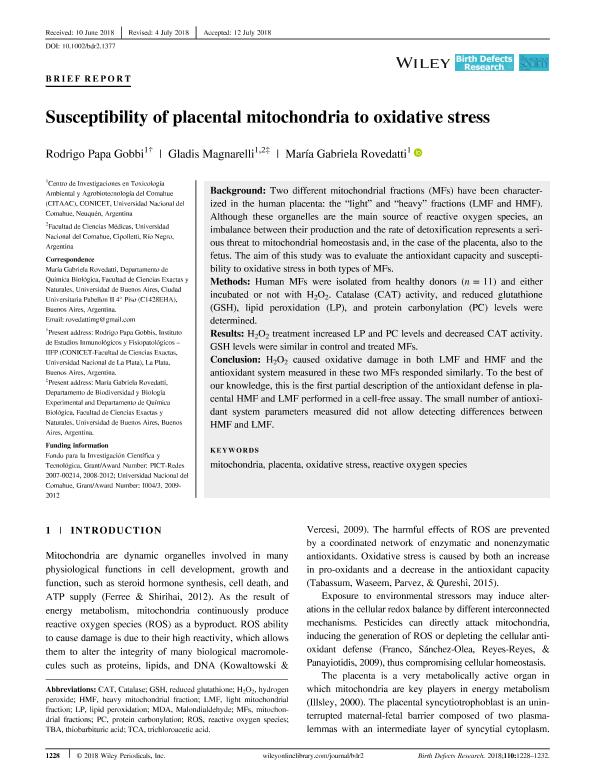Artículo
Susceptibility of placental mitochondria to oxidative stress
Fecha de publicación:
10/2018
Editorial:
John Wiley & Sons
Revista:
Birth Defects Research
e-ISSN:
2472-1727
Idioma:
Inglés
Tipo de recurso:
Artículo publicado
Clasificación temática:
Resumen
Background: Two different mitochondrial fractions (MFs) have been characterized in the human placenta: the “light” and “heavy” fractions (LMF and HMF). Although these organelles are the main source of reactive oxygen species, an imbalance between their production and the rate of detoxification represents a serious threat to mitochondrial homeostasis and, in the case of the placenta, also to the fetus. The aim of this study was to evaluate the antioxidant capacity and susceptibility to oxidative stress in both types of MFs. Methods: Human MFs were isolated from healthy donors (n = 11) and either incubated or not with H2O2. Catalase (CAT) activity, and reduced glutathione (GSH), lipid peroxidation (LP), and protein carbonylation (PC) levels were determined. Results: H2O2 treatment increased LP and PC levels and decreased CAT activity. GSH levels were similar in control and treated MFs. Conclusion: H2O2 caused oxidative damage in both LMF and HMF and the antioxidant system measured in these two MFs responded similarly. To the best of our knowledge, this is the first partial description of the antioxidant defense in placental HMF and LMF performed in a cell-free assay. The small number of antioxidant system parameters measured did not allow detecting differences between HMF and LMF.
Palabras clave:
MITOCHONDRIA
,
OXIDATIVE STRESS
,
PLACENTA
,
REACTIVE OXYGEN SPECIES
Archivos asociados
Licencia
Identificadores
Colecciones
Articulos(CITAAC)
Articulos de CENTRO DE INVESTIGACIONES EN TOXICOLOGIA AMBIENTAL Y AGROBIOTECNOLOGIA DEL COMAHUE
Articulos de CENTRO DE INVESTIGACIONES EN TOXICOLOGIA AMBIENTAL Y AGROBIOTECNOLOGIA DEL COMAHUE
Articulos(IIFP)
Articulos de INST. DE ESTUDIOS INMUNOLOGICOS Y FISIOPATOLOGICOS
Articulos de INST. DE ESTUDIOS INMUNOLOGICOS Y FISIOPATOLOGICOS
Citación
Papa Gobbi, Rodrigo; Magnarelli, Gladis Griselda; Rovedatti, María Gabriela; Susceptibility of placental mitochondria to oxidative stress; John Wiley & Sons; Birth Defects Research; 110; 16; 10-2018; 1228-1232
Compartir
Altmétricas




